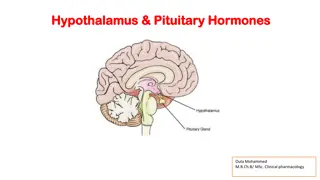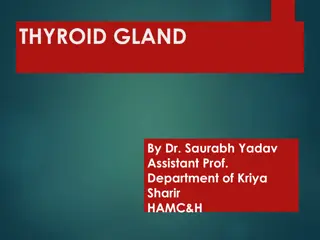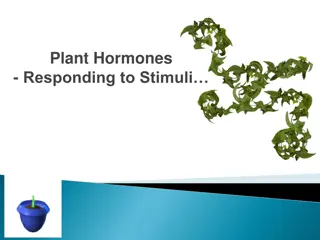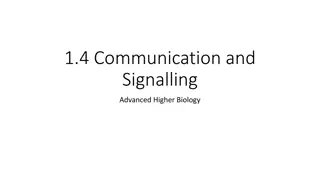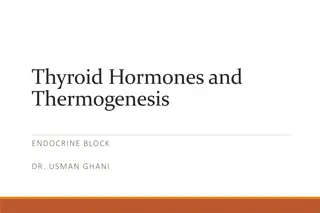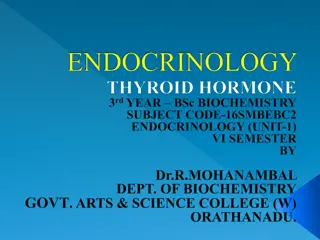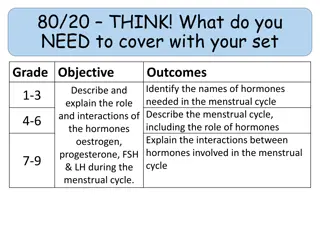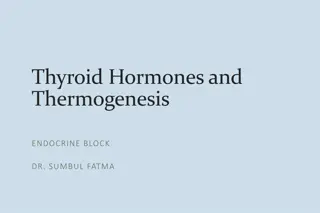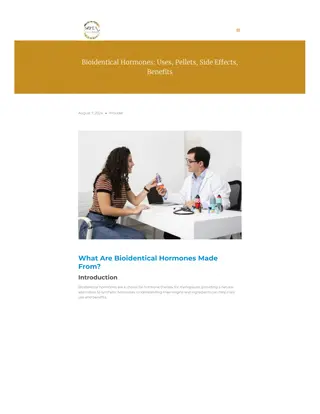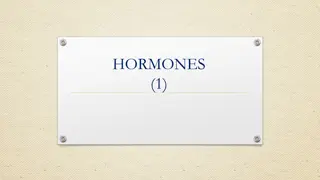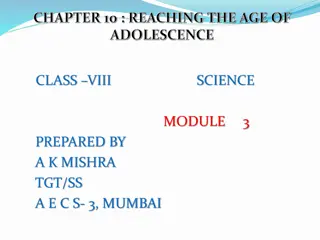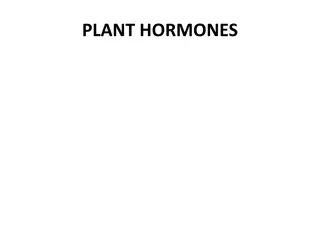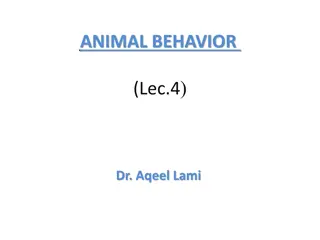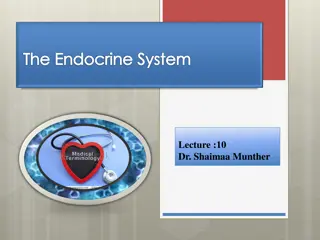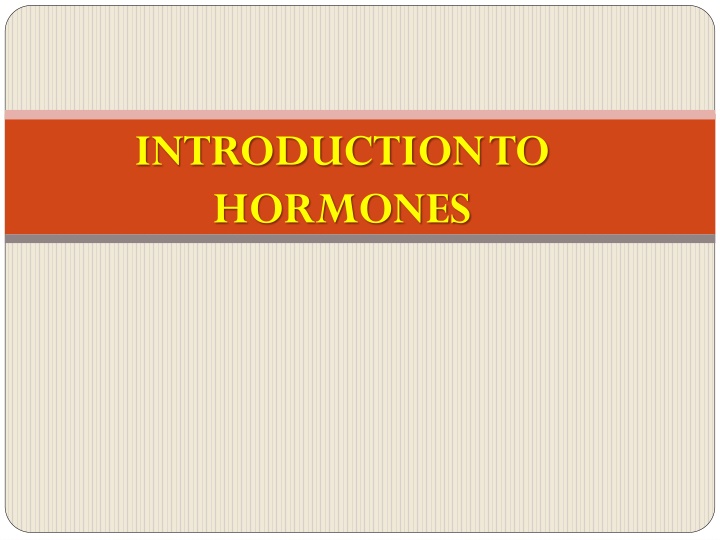
Understanding Hormones and Their Role in the Body
Explore the intricate world of hormones with this informative content covering the basics of endocrinology, the functions of different types of hormones, and how hormones interact with target organs. Learn about the classification of hormones based on chemical nature and mechanism of action, as well as the factors regulating hormone action at target organs.
Download Presentation

Please find below an Image/Link to download the presentation.
The content on the website is provided AS IS for your information and personal use only. It may not be sold, licensed, or shared on other websites without obtaining consent from the author. If you encounter any issues during the download, it is possible that the publisher has removed the file from their server.
You are allowed to download the files provided on this website for personal or commercial use, subject to the condition that they are used lawfully. All files are the property of their respective owners.
The content on the website is provided AS IS for your information and personal use only. It may not be sold, licensed, or shared on other websites without obtaining consent from the author.
E N D
Presentation Transcript
INTRODUCTION TO HORMONES
ENDOCRINOLOGY The multiple activities of the cell, tissue and organs of the body are coordinate by the interplay of several types of communication systems including ; 1. Neural : In which chemical (neurotransmitters )are released at synaptic functions and act locally to control call function. 2. Endocrine In which glands a specialized cells release into the circulating blood chemicals that influence the function of cells at another location in the body. 3. Neuroendocrine In which neurons secrete substances (Neuro hormones) that reach the circulating blood and influence the function of cells at another location in the body. 4. Paracrine In which cell secrete substances that diffuse into the extra cellular fluid and effect neibhouring cells. 5. Autocrine In which a cell secretes substances that effect the function of the same cell by binding to the cell surface receptors.
Hormones are secreted by endocrine or dutless glands. They catalyse and control diverse metabolic processes : They resmble enzymes in two ways i. They act as a catalyst ii. They are needed in small amounts and are not used up in the reaction. The difference b/w enzymes and hormones are : Enzymes They are utilized at the site where they are produced Hormones They are produced in one organ and they perform their action in another organ or target organ. Structurally they all are not proteins but only some are protein in nature. Eg. Insulin They are discharged in the blood prior to use. Structurally they all are proteins. Most of the enzymes are synthesize at the cellular level where they perform their function.
Reaction of Action of Hormones At a target organ the action of hormones is regulated by 5 factors : i. Rate of synthesis and secretion of the stored hormone from the endocrine gland. ii. Specific transport systems in plasma. iii. In some ceases conversion to more active form. iv. Hormone specific receptors in target cells. v. Ultimate degradation of the hormone mainly by liver or kidney.
2. Autocrine Hormones They act on the same cells where they are synthesized. For Eg. Interleukins2 produced by T-cells is responsible for the stimulation of their proliferation. Neurotransmitters are released by nerve cells & usually act on the adjacent cells. There are almost similar to the hormones in respect to the synthesis of their transport and mechanism action. CLASSIFICATION OF HORMONES Type-1 : Based on the chemical nature Type-2 : Based on the mechanism of action. Type-I: Based on the Chemical Nature 1. Protein or peptide Hormones : Insulin oxytoxin glucagon, ADH (Anti Diuretic Hormone). 2. Steroid Hormones : For Eg. Sex, hormones, glucocorticoids, nineralocorticoids.
3. Amino Acid Derivatives For Eg.-Thyroxine T4, Triodo thyronine T3, Epinephrine, Non- epinhphrine. Type-II: Based on the Mechanism of Action Hormones can also be classified into 2 broad groups based on the location of receptors to which they bind and he signals used to mediate their action. 1. Group-1 -Hormones These hormones bind to intracellular receptor hormone complexes through which their biochemical functions are mediated except T3 and T4 group. For Eg. : Estrogen & progestrone, glucocorticoids etc. These hormones act through the intracellular receptors located either in the cytosol or the nucleus. The hormone receptor complex binds to specific regions on the DNA and causes inc. expression of specific genes. The ultimate outcome is the production of specific in response to hormonal action.
2. Group-2-Hormones These hormones bind to cell surface or plasma membrane and stimulate the release of II messenger or certain molecules. These messengers perform the biochemical functions. These hormones are hydrophilil in nature and usually transported in the free from and causes short half life. The hormones are: FSH (Follicle stimulating hormone). LH (Leutinizing Hormone) PTH (Para thyroid hormone) ACTH (Adreno cartic, trophic hormone) Glycogen and calcitonin These stimulate release of second messenger cAMP (cyclic AMP). These hormones are subdivided into: TRH (Thyrotropin Release Hormone) Gastrin etc. which stimulate release of phosphotidyl inositol, calcium as II messenger. Hormone such as GH (Growth Hormone) insulin, oxytocin, prolactin. The II messenger released by these hormones is still unknown.
Action of Phosphotidyl Inositol/Calcium System The hormone receptor complex to G. protein activates the membrane enzyme phospholipase C. This enzyme clears phosphatidyl inositol 4,5 bi phosphate (P1P2) to yield, 1,2 diacyl glycerol and inositol 1,4,5 triphosphate (Ins P3) The function of InsP3 is to inc. intrcellular calcium. Action of In s P3 : It posses through the cytoplasm and stimulates the endoplasmic reticulum to release calcium ions which contribute to a variety of bio- chemical processes. Ins P3 is a short live chemical messenger. Action of 1, 2 Diacyl Glycerol (DG): The DG being non-polar is retained in the membrane where it function as a II messenger. It activates the membrane bound enz. protein kinase c. In the presence of Ca++. The calcium ions are obtained from the ER by stimulating InsP3. The enz. protein kinas C and calcium dependent calmodulin kinase bring about the protein phosphoryletion.
Action of Phosphotidyl Inositol/Calcium System The hormone receptor complex to G. protein activates the membrane enzyme phospholipase C. This enzyme clears phosphatidyl inositol 4,5 bi phosphate (P1P2) to yield, 1,2 diacyl glycerol and inositol 1,4,5 triphosphate (Ins P3) The function of InsP3 is to inc. intrcellular calcium. Action of In s P3 : It posses through the cytoplasm and stimulates the endoplasmic reticulum to release calcium ions which contribute to a variety of bio- chemical processes. Ins P3 is a short live chemical messenger. Action of 1, 2 Diacyl Glycerol (DG): The DG being non-polar is retained in the membrane where it function as a II messenger. It activates the membrane bound enz. protein kinase c. In the presence of Ca++. The calcium ions are obtained from the ER by stimulating InsP3. The enz. protein kinas C and calcium dependent calmodulin kinase bring about the protein phosphoryletion.
Action of Phosphotidyl Inositol/Calcium System Water soluble hormones like peptides and capechool amines are dissolved in the plasma and transported from their sites of syntehsis to target tissues where they diffuse out of the capillaries into the interstitial fluid and ultimately to target cells. Steroid and thyroid hormones in contrast circulate in the blood . Mainly bound to plasma proteins. Usually less than 10% of the steroid or thyroid hormones in the plasma exists free in solution. For Eg. More than 99% of the thyroxine in the blood is bound to plasma proteins. However, protein bound hormones cannot easily diffuse across the capillaries and gain acess to their target cells and are therfore, biologically inactive while they dissociate from plasma proteins. The relatively large amounts of hormones bound to proteins serve as reservoirs, replenishing the concentration of free hormones when they are bound to target receptors or last from the circulation.
Clearance of Hormones from the Blood 2 Factors can increasing or decreasing the concentration of a hormone in the blood. One of these is the rate of hormone secretion into the blood. The second is the rate of removal of the hormone from the blood which is called the metabolic clearance rate. This is usually expressed in the terms of the no. of mililitres of the plasma cleared of the hormone per min. Hormones are cleared from the plasma in several ways: 1. Metabolic destruction by the tissues. 2. Binding with the tissues. 3. Excretion by the liver into the bite. 4. Excretion by the kidneys into the urie.
For certain hormones a decreased metabolic clearance rate frequently causes and excessively high concentration of the hormone in the circulating body fluids. For instance this occurs for several of the steroid hormones when the liver is diseased, because these hormones are mainly conjugated in the liver and their cleared into the bile.


